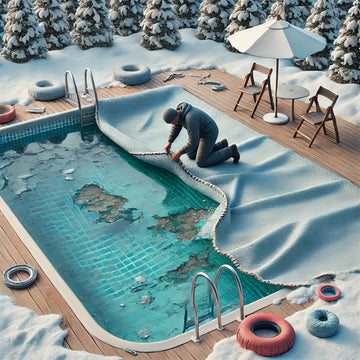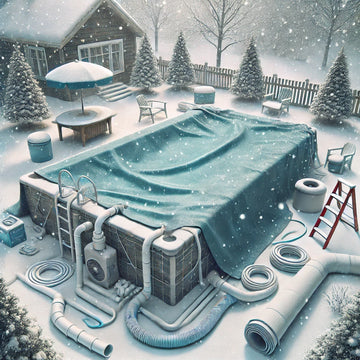How to Handle Winter Pool Safety Cover Damage
As a pool owner, ensuring your investment is protected year-round is a top priority. From pool safety cover installation to winterizing your pool, you've done everything right to keep it in great shape. However, Ottawa's winters can be harsh on your swimming pool safety cover, and despite your best efforts, damage can happen.
Whether it's from heavy snow, ice, or wildlife, understanding what causes pool cover damage and knowing how to repair it will help you extend the life of your cover and protect your pool through the off-season.
Common Causes of Pool Safety Cover Damage
Even the most durable in-ground pool safety covers can suffer from wear and tear, especially during the cold, unpredictable months. Here are the most common culprits for winter damage:
- Heavy snow and ice: When large amounts of snow and ice accumulate on your cover, the weight can cause it to stretch, sag, or even tear. Although pool safety covers are built to handle winter conditions, extreme weight from snow can push the material beyond its limits.
- Strong winter winds: Harsh winds can blow debris, such as branches or sticks, onto your safety pool cover, causing rips and holes.
- Wildlife: Small animals, such as squirrels or raccoons, may attempt to walk across your cover, especially when snow hides the pool's surface. Their claws can puncture or rip the fabric.
- Condensation and freezing: When moisture becomes trapped on the cover, it can freeze into sharp ice formations, potentially cutting into the material and leading to further damage (winter temperatures that freeze and unfreeze often).
Identifying these causes early can help you take proactive steps to prevent further issues and maintain the integrity of your pool safety cover throughout the winter.
Quick Fixes for Minor Damage
If you discover small tears or minor damage to your pool safety cover, don't panic. Many issues can be resolved with quick, effective repairs that will extend the life of your cover. Here's what you can do:
- Patch Small Tears: If you notice any small rips or cuts, especially near the edges of your cover, you can use an adhesive patch to fix the damage before it worsens. Be sure to use patches designed specifically for swimming pool safety covers to ensure durability.
- Reposition a Dislodged Cover: If wind or heavy snow has caused your safety cover to shift, carefully remove the debris and reposition the cover back in place. Make sure to clear away any accumulated snow and ice before adjusting the cover, as attempting to move it under a heavy load could lead to further damage.
- Check and Tighten Pool Cover Anchors: Inspect the pool safety cover anchors to ensure they are still secure. Over time, they can loosen, especially after strong winds. Tighten any loose anchors and ensure they are properly aligned so the cover remains tight and effective throughout the winter.
For more in-depth guidance on installing and maintaining pool safety covers, check out our Pool Safety Cover Installation Guide
When to Call a Professional for Pool Cover Repairs
While the pool owner can often repair minor damage, more significant issues like large tears, sagging, or damage around the edges may require professional help. Suppose your cover has extensive damage or wear. In that case, it's best to call a pool safety cover repair service to assess the situation.
Suppose your 16x32 safety pool cover, for example, has multiple tears or damage that affects its ability to protect your pool. In that case, a complete replacement might be necessary. Professional pool specialists in Ottawa can help determine whether a replacement or repair is better for your pool's safety.
Before sending the cover in for repair, clean it off and clearly mark the areas that need attention. Correctly identifying the damage will help speed up the repair process and ensure that the cover is returned in optimal condition and ready for the remainder of the season.
Looking for a reliable repair service? Our pool safety cover installation experts provide comprehensive repair services for winter-damaged covers. Learn more about our installation and repair options on our pool safety cover installation page.
Preventing Future Pool Cover Damage
While damage to your pool safety cover is sometimes unavoidable, there are steps you can take to minimize future issues. Here's how you can protect your pool and its cover for the seasons to come:
- Regular inspections: Check your pool cover throughout the winter for signs of damage, especially after heavy snowfalls or storms.
- Timely snow removal: To prevent heavy snow and ice from building up on your pool cover, use a soft brush or snow rake to gently remove snow without damaging the material (if a pool professional recommends it).
- Wildlife deterrents: To prevent wildlife from accessing your pool cover, consider using deterrents like fencing or simply clearing your yard regularly to make it less appealing to animals.
By following these steps, you can prevent minor issues from becoming costly repairs and keep your in-ground pool safety cover functioning optimally for years to come.
Conclusion: Keep Your Pool Safe All Year Round
Maintaining your winter pool safety cover is crucial for protecting your pool and ensuring it's ready to use when the warmer months return. Whether you need to fix small tears or replace an aging cover, addressing problems as soon as they arise will save you from more extensive and expensive repairs down the line.
Suppose you need help assessing your cover or managing repairs. In that case, our team in Ottawa is ready to assist with everything from pool safety cover installation to post-season repairs. We're committed to keeping your pool safe, protected, and well-maintained throughout the year.
For more on pool cover installation, visit our Ultimate Guide to Pool Safety Cover Installation.
Looking to install a new pool safety cover? If your current cover is beyond repair, it may be time for an upgrade. Visit our Pool Safety Cover Installation page to explore high-quality, durable covers that are custom-fit for your pool and designed to withstand Ottawa's harsh winters.




